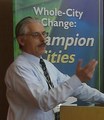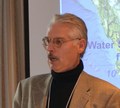FLASHBACK TO 2008: At the Green Developers Dialogue, Tim Pringle illustrated how Green Value had moved from market-niche to market-share on Vancouver Island

The Real Estate Foundation of BC hosted the Green Developers Roundtable at the 2008 Gaining Ground Summit. “We organized the roundtable event to engage the major Vancouver Island developers in a conversation about the factors that facilitate or hinder their efforts to design, plan for and implement development incorporating Green Value Strategies on Vancouver Island,” said Jack Hall, REFBC Chair at that time.










